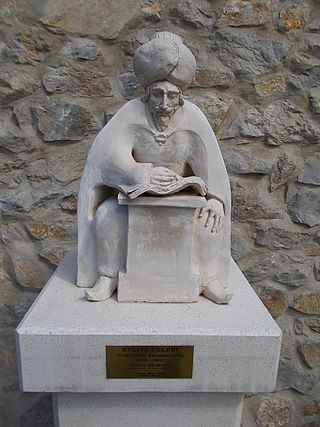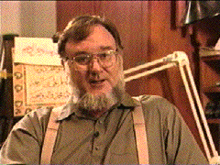
Dervish Mehmed Zillî, known as Evliya Çelebi, was an Ottoman explorer who travelled through the territory of the Ottoman Empire and neighboring lands during the empire's cultural zenith. He travelled for over 40 years, recording his commentary in a travelogue called the Seyahatnâme. The name Çelebi is an honorific meaning "gentleman" or "man of God".

Arabic calligraphy is the artistic practice of handwriting and calligraphy based on the Arabic alphabet. It is known in Arabic as khatt, derived from the word 'line', 'design', or 'construction'. Kufic is the oldest form of the Arabic script.

Islamic calligraphy is the artistic practice of handwriting and calligraphy, in the languages which use Arabic alphabet or the alphabets derived from it. It includes Arabic, Persian, Ottoman, and Urdu calligraphy. It is known in Arabic as khatt Arabi, which translates into Arabic line, design, or construction.
Hasan Çelebi, born 1937 in Erzurum, Turkey, is a Turkish master of Islamic calligraphy. He is a student of Hamid Aytaç.

Sheikh Hamdullah (1436–1520), born in Amasya, Ottoman Empire, was a master of Islamic calligraphy.
Hattat Aziz Efendi was an Ottoman calligrapher.
Holiday stamps are a type of postage stamp issued to commemorate a particular religious festival or holiday.

Uthman ibn Abduh ibn Husayn ibn Taha al-Halyabi is a Syrian-Saudi calligrapher of the Quran in the Arabic language renowned for hand-writing Mushaf al-Madinah issued by the King Fahd Complex for the Printing of the Holy Qur'an.

Hâfiz Osman (1642–1698) was an Ottoman calligrapher noted for improving the script and for developing a layout template for the hilye which became the classical approach to page design.

Yaqut al-Musta'simi was a well-known calligrapher and secretary of the last Abbasid caliph.

The term ḥilya denotes both a visual form in Ottoman art and a religious genre of Ottoman Turkish literature, each dealing with the physical description of Muhammad. Hilya means "ornament". They originate with the discipline of shama'il, the study of Muhammad's appearance and character, based on hadith accounts, most notably al-Tirmidhi's Shama'il al-Muhammadiyya "The Sublime Characteristics of Muhammad". In Ottoman-era folk Islam, there was a belief that reading and possessing Muhammad's description protects the person from trouble in this world and the next, it became customary to carry such descriptions, rendered in fine calligraphy and illuminated, as amulets. In 17th-century Ottoman Turkey, ḥilān developed into an art form with a standard layout, often framed and used as a wall decoration. Later ḥilān were written for the four Rashid caliphs, the Companions of the Prophet, Muhammad's grandchildren Hasan and Husayn, and walis or saints.

Ahmed Karahisari (1468–1566) was an Ottoman calligrapher.
Soraya Syed Sanders is an English classically trained Islamic calligrapher and artist. She uses classical Arabic calligraphy with new technologies such as holography, placing a traditional art-form into contemporary context.
Emrich Nicholson (1913–2001) was an American art director for Paramount and Universal Studios and painter of murals, and designer of furniture and merchandise associated with the 1939 New York World's Fair. In 1948, he was nominated for an Academy Award for art direction for the film One Touch of Venus. He later was the national art director for the Loe Burnett Company advertising agency. Nicholson was the father of American calligrapher and stamp designer Mohamed Zakariya and three other children by his wife, Amy Aplin.
Hamid Aytaç was an Islamic calligrapher born during Ottoman times. In his later life, he was acknowledged as the Islamic world's leading calligrapher and was one of the last of the classical calligraphers.

Hashem Muhammad al-Baghdadi (1917–1973) was an Iraqi master calligrapher, noted for his lettering which exhibited a steadiness of hand and fluidity of movement. In his later life, he was acknowledged as the "imam of calligraphy" across the Arab world, and would be the last of the classical calligraphers. He also authored several important texts on the art of calligraphy.
Nuria Garcia Masip is a Spanish calligrapher of Arabic calligraphy. She started to learn Arabic calligraphy when she visited Morocco. In 2000, she learned Arabic calligraphy under the tutelage of calligrapher Mohamed Zakariya. Her interest in calligraphy took her to Istanbul, where she learned the various scripts and styles of Arabic calligraphy from Hasan Çelebi and Davut Bektaş. In 2007, she received a certificate in the Thuluth and Naskh scripts.

The art of Turkish calligraphy dates back to the seventh century. The Ottoman Turks migrated from Central Asia to establish an empire in Anatolia by 1299, and conquered Constantinople in 1453. The Ottoman Empire became a major European power. After the fall of the Mamluk Sultanate (1517), the Ottomans began to exert great influence over Islamic art and placed great emphasis on calligraphy. They collaborated with Egyptian and Persian calligraphers, adopting the naskh and thuluth scripts.










